This Friday, March 1st, the school will be having a trimester assembly recognizing many activities like cheerleading, bowling, etc.
Besides those two, they will also be recognizing the students that earned all A's for this trimester, students who were accepted into Honors Orchestra, Choir, and Band, girls, and guys basketball for 6th, 7th, and 8th grade, and finally, students in Wrestling.
Be sure to be there!
Thursday, February 28, 2019
Mrs. Mahl's Dream Come True
Have you ever wanted to pull a fire alarm without an emergency and face no consequences? Our 8th grade science teacher Mrs. Mahl certainly has. This school year, she finally got the opportunity she wanted. Mrs. Mahl was offered the chance to pull the fire alarm for the recent school fire drill, to which she delightfully accepted. To better understand what the experience was like, I interviewed her. When interviewing her, I wanted to start at the beginning with how she she received this opportunity.
 How did you get the opportunity to pull the fire alarm?
How did you get the opportunity to pull the fire alarm?
Last year I found out that Mr. Gladden got to pull the fire alarm and was excited and jealous that he got have this opportunity. I have always wanted to pull a fire alarm. So luckily I was offered the opportunity. Crossed that one off my bucket list.
How did you feel the moment you found out?
I was so incredibly excited. I had Mrs. Rospert document the event so can put it in my February scrapbook for Garrett’s class.
Next, I wanted to know more about actually pulling the alarm.
What was going through your mind as you pulled the alarm?
I just couldn’t believe one of my biggest dreams was about to come true.
Did the experience live up to your expectations?
Actually only partly. I thought it would be a more instantaneous alarm, but after I pulled it there was a good 5 second delay before the lights and alarms went off.
Is there anything else you would like to add about the experience?
I would say that if you are offered the chance to fulfill a dream, no matter how silly someone thinks it is, take that opportunity!
 How did you get the opportunity to pull the fire alarm?
How did you get the opportunity to pull the fire alarm?Last year I found out that Mr. Gladden got to pull the fire alarm and was excited and jealous that he got have this opportunity. I have always wanted to pull a fire alarm. So luckily I was offered the opportunity. Crossed that one off my bucket list.
How did you feel the moment you found out?
I was so incredibly excited. I had Mrs. Rospert document the event so can put it in my February scrapbook for Garrett’s class.
Next, I wanted to know more about actually pulling the alarm.
What was going through your mind as you pulled the alarm?
I just couldn’t believe one of my biggest dreams was about to come true.
Did the experience live up to your expectations?
Actually only partly. I thought it would be a more instantaneous alarm, but after I pulled it there was a good 5 second delay before the lights and alarms went off.
Is there anything else you would like to add about the experience?
I would say that if you are offered the chance to fulfill a dream, no matter how silly someone thinks it is, take that opportunity!
Flashtime Escape Room!
On March 15th, for 8th graders, during Flashtime A or C the 8th grade teachers will be hosting an escape room! For 7th grade the escape room will be on March 22, and for 6th grade it will be on March 29. Flashtimes will be competing against each other to win! This will be a team building activity to strengthen your Flashtime’s friendships and reliability. Mark the date on your calendar and be prepared to win!
Share the Screen
By Anya Kamenetz
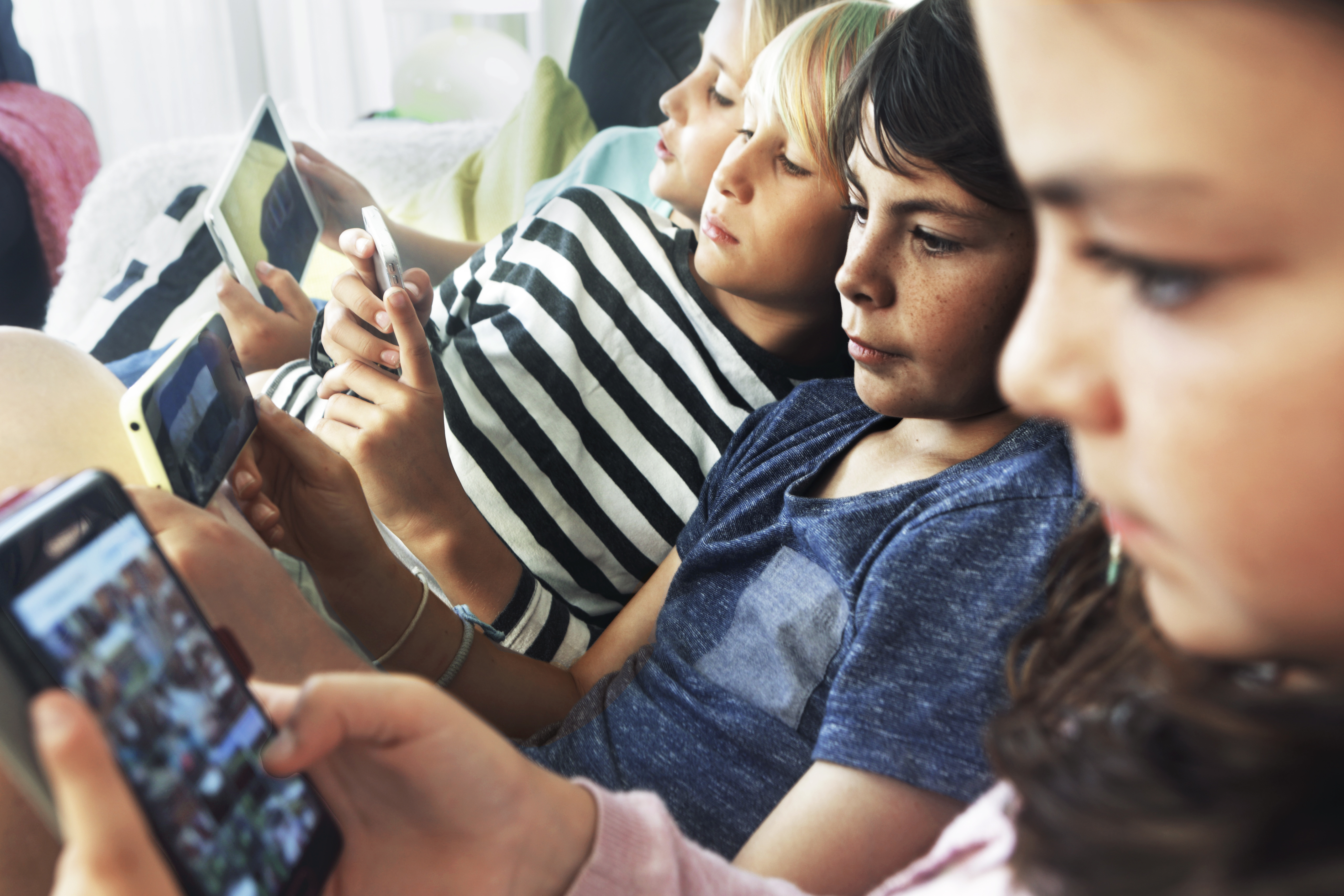
TAKE A BREAK Excessive screen time can increase obesity and prevent users from getting enough sleep.
PETER CADE—GETTY IMAGES
Anya Kamenetz is the author of The Art of Screen Time: How Your Family Can Balance Digital Media and Real Life. She argues that a healthy life includes limited screen time enjoyed in the company of family and friends.
WILL O'HARE
Have you ever argued with your parents about putting away the tablet or turning off a video game? Most families are having these battles. In 2018, Brigham Young University and Deseret News conducted their American Family Survey. It showed that the Number 1 fear for parents of teenagers was too much technology.
If you’re in school now, you may not remember a time before there were smartphones and tablets everywhere. The iPhone was introduced in 2007, and the iPad came out a few years later, in 2010. But screen time is nothing new. When your parents were growing up, they watched as much television as you do now, or even more. They probably played video games, too.
Mobile devices are different, though, because they can come with us everywhere we go: to the dinner table, to restaurants, into the car, into the bedroom when we’re going to sleep. They are programmed to constantly remind us to pick them up or to keep using them. That’s part of what makes smartphones smart! But it also means that they are always interrupting us when we’re trying to have family time or fun with friends. And unlike with TV, which people often watch as a family, everyone—including parents—is now distracted by his or her own little machine.
Scientists who study the effects of media say too much screen time can cause problems. More than two hours a day of screen time raises your risk of being overweight. Too much screen time at night stops you from getting healthy sleep. Children who grow up with the most screen time (several hours a day) can have a hard time focusing and doing well in school. And many families fight about screen time, which is no fun for anyone.
The solution is to talk about screen time. Make an agreement with your family about where, when, and how you are going to use computers and other devices. No more than an hour a day is recommended for kids during the school week. Parents, too, should put down their phones.
When you do use a device, consider enjoying it with your family, perhaps by playing games or watching a movie. The American Academy of Pediatrics calls this “joint media engagement,” and says it’s the best way for kids to grow up healthy in our digital world.

TAKE A BREAK Excessive screen time can increase obesity and prevent users from getting enough sleep.
PETER CADE—GETTY IMAGES
Anya Kamenetz is the author of The Art of Screen Time: How Your Family Can Balance Digital Media and Real Life. She argues that a healthy life includes limited screen time enjoyed in the company of family and friends.
WILL O'HARE
Have you ever argued with your parents about putting away the tablet or turning off a video game? Most families are having these battles. In 2018, Brigham Young University and Deseret News conducted their American Family Survey. It showed that the Number 1 fear for parents of teenagers was too much technology.
If you’re in school now, you may not remember a time before there were smartphones and tablets everywhere. The iPhone was introduced in 2007, and the iPad came out a few years later, in 2010. But screen time is nothing new. When your parents were growing up, they watched as much television as you do now, or even more. They probably played video games, too.
Mobile devices are different, though, because they can come with us everywhere we go: to the dinner table, to restaurants, into the car, into the bedroom when we’re going to sleep. They are programmed to constantly remind us to pick them up or to keep using them. That’s part of what makes smartphones smart! But it also means that they are always interrupting us when we’re trying to have family time or fun with friends. And unlike with TV, which people often watch as a family, everyone—including parents—is now distracted by his or her own little machine.
Scientists who study the effects of media say too much screen time can cause problems. More than two hours a day of screen time raises your risk of being overweight. Too much screen time at night stops you from getting healthy sleep. Children who grow up with the most screen time (several hours a day) can have a hard time focusing and doing well in school. And many families fight about screen time, which is no fun for anyone.
The solution is to talk about screen time. Make an agreement with your family about where, when, and how you are going to use computers and other devices. No more than an hour a day is recommended for kids during the school week. Parents, too, should put down their phones.
When you do use a device, consider enjoying it with your family, perhaps by playing games or watching a movie. The American Academy of Pediatrics calls this “joint media engagement,” and says it’s the best way for kids to grow up healthy in our digital world.
Wednesday, February 27, 2019
Ready for Class!
By Shay Maunz
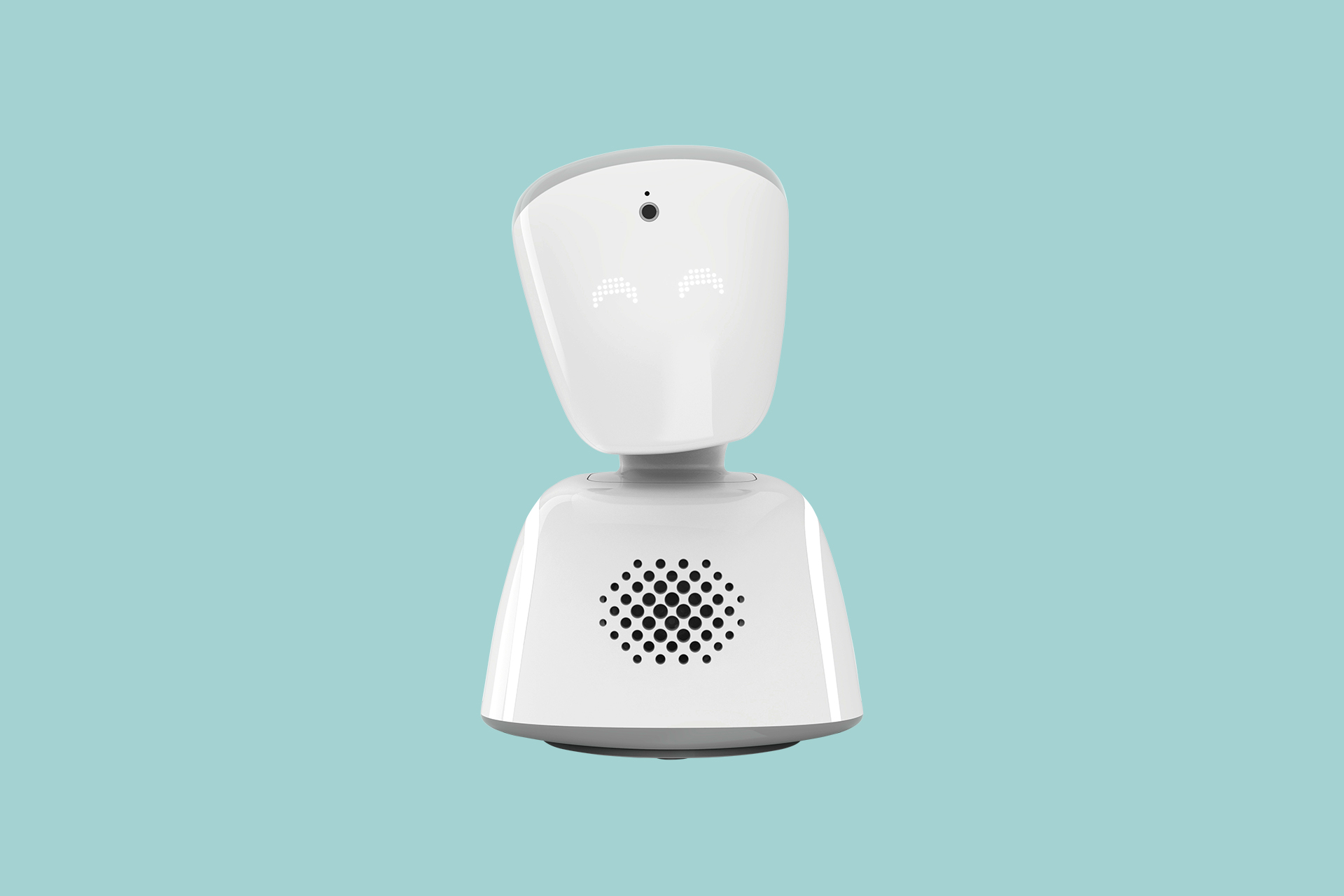
When Makayla Nunn was 8, she was diagnosed with a rare illness called chronic fatigue syndrome. People with this condition are regularly overcome by extreme tiredness. The feeling doesn’t go away when they sleep or rest.
Makayla lives in the United Kingdom. Because of her illness, she had to give up some of her hobbies, including baton twirling, ballet, and horseback riding. On her doctor’s orders, she started spending no more than three hours at school each day. She soon fell behind in her studies, and she missed her friends. “I would love to see them more,” Makayla, now 15, told TIME for Kids. Then Makayla’s mom introduced her to a tool that would help her keep on top of schoolwork and stay connected to friends. It was a robot called AV1.
Hi, Robot
AV1 is 11 inches tall and weighs about two pounds. It has a white body, glowing eyes, a speaker, a microphone, and wireless Internet access. The robot was developed to help kids who have a chronic illness.
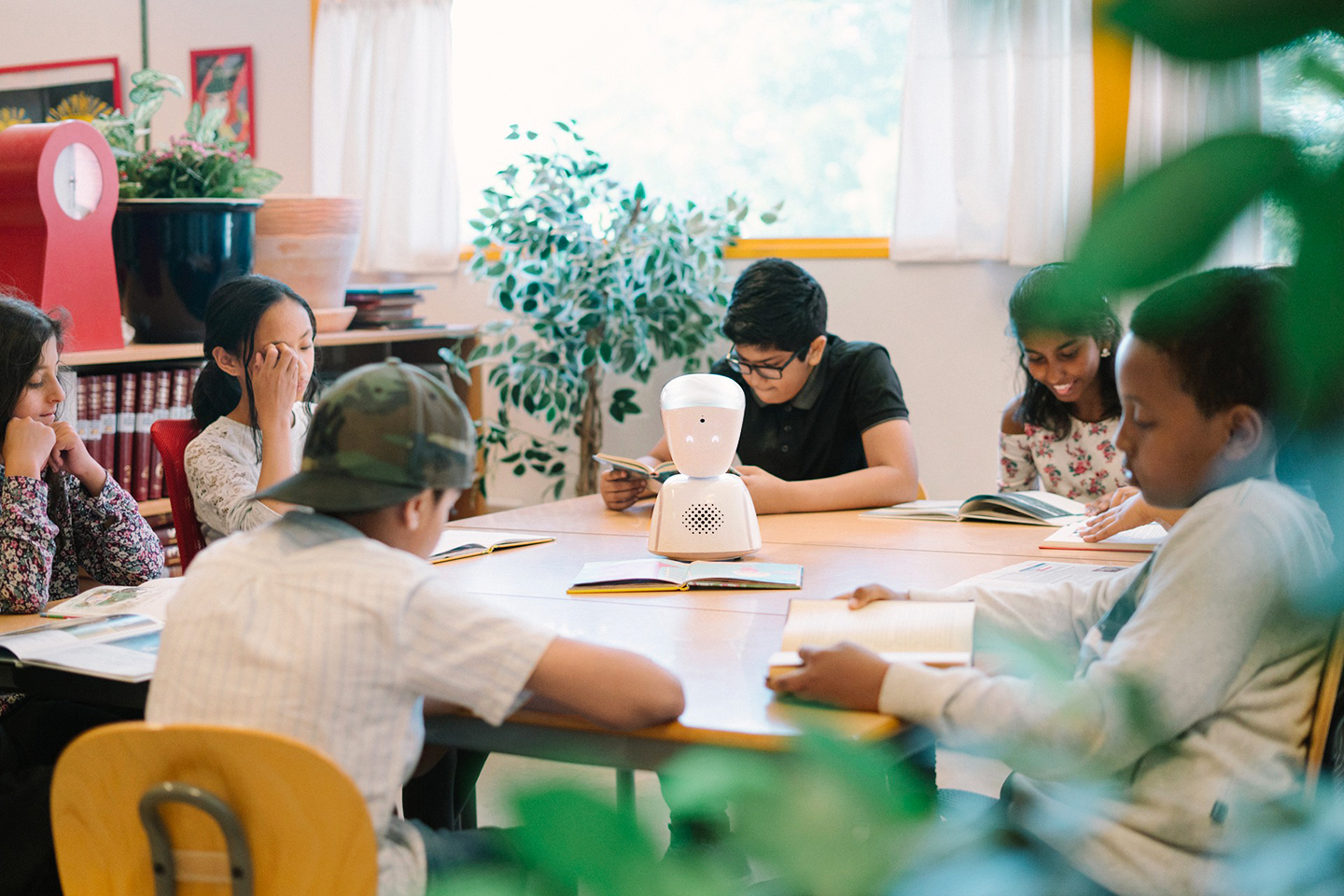
PART OF THE GROUP Students work together on an assignment. One student is participating from home using an AV1 robot.
ESTERA KLUCZENKO
Now, when Makayla can’t make it to school, AV1 takes her place. If she feels well enough to take part in a lesson, she opens an app on her phone. She uses AV1’s camera to see what’s happening in the classroom. She can “raise her hand” by tapping a button that makes a light on AV1’s head flash blue. When she speaks, AV1 broadcasts her voice.
AV1 isn’t the only technology that lets kids who are sick attend school remotely. But AV1 is uniquely designed to encourage social interaction. The robot’s expressive eyes let Makayla convey emotions such as happiness or sadness. The whisper function allows her to speak with friends without interrupting the teacher. And AV1 is portable, so Makayla’s friends can carry it to recess or on social outings. (AV1 is now available only in Europe, but it will soon be available in the U.S.)
Makayla’s classmates nicknamed her robot Robbie. One staff member even made Robbie a coat so it wouldn’t get cold while traveling between school buildings.
Karen Dolva cofounded No Isolation, the company that makes AV1, in 2015. “When you’re not in school, you miss out on all these small, magical moments and interactions,” Dolva told TFK. “AV1 helps you stay involved in the conversation.”

When Makayla Nunn was 8, she was diagnosed with a rare illness called chronic fatigue syndrome. People with this condition are regularly overcome by extreme tiredness. The feeling doesn’t go away when they sleep or rest.
Makayla lives in the United Kingdom. Because of her illness, she had to give up some of her hobbies, including baton twirling, ballet, and horseback riding. On her doctor’s orders, she started spending no more than three hours at school each day. She soon fell behind in her studies, and she missed her friends. “I would love to see them more,” Makayla, now 15, told TIME for Kids. Then Makayla’s mom introduced her to a tool that would help her keep on top of schoolwork and stay connected to friends. It was a robot called AV1.
Hi, Robot
AV1 is 11 inches tall and weighs about two pounds. It has a white body, glowing eyes, a speaker, a microphone, and wireless Internet access. The robot was developed to help kids who have a chronic illness.

PART OF THE GROUP Students work together on an assignment. One student is participating from home using an AV1 robot.
ESTERA KLUCZENKO
Now, when Makayla can’t make it to school, AV1 takes her place. If she feels well enough to take part in a lesson, she opens an app on her phone. She uses AV1’s camera to see what’s happening in the classroom. She can “raise her hand” by tapping a button that makes a light on AV1’s head flash blue. When she speaks, AV1 broadcasts her voice.
AV1 isn’t the only technology that lets kids who are sick attend school remotely. But AV1 is uniquely designed to encourage social interaction. The robot’s expressive eyes let Makayla convey emotions such as happiness or sadness. The whisper function allows her to speak with friends without interrupting the teacher. And AV1 is portable, so Makayla’s friends can carry it to recess or on social outings. (AV1 is now available only in Europe, but it will soon be available in the U.S.)
Makayla’s classmates nicknamed her robot Robbie. One staff member even made Robbie a coat so it wouldn’t get cold while traveling between school buildings.
Karen Dolva cofounded No Isolation, the company that makes AV1, in 2015. “When you’re not in school, you miss out on all these small, magical moments and interactions,” Dolva told TFK. “AV1 helps you stay involved in the conversation.”
Tuesday, February 26, 2019
All About Bots
By Constance Gibbs

FROM LEFT: COURTESY RAUL LAPEIRA; STEPHEN BLUE FOR TIME FOR KIDS
When you think of robots, you may think of a machine with a human shape. But robotics takes many forms. Did you know the temperature inside your refrigerator is regulated by robotics? When you ride in an airplane, the pilot is assisted by robotics during takeoff and landing. Someday, it may be possible for a robot to drive you to school.
The Maker’s Guide to Building Robots introduces readers to these kinds of robots and many more. The book is also a guide for kids who would like to build a robot of their own. Handy shopping lists help bot-builders collect the necessary supplies. Step-by-step instructions explain how to assemble a robot and write code so it will obey commands.
ANDREU MARSAL (pictured) is one of the book’s authors. Marsal hopes readers will use the book to devise their own robots. “We aim to show situations where a robot is used to solve a problem,” he told TFK. “Would readers be able to identify similar situations in the real world and think of a solution?”

FROM LEFT: COURTESY RAUL LAPEIRA; STEPHEN BLUE FOR TIME FOR KIDS
When you think of robots, you may think of a machine with a human shape. But robotics takes many forms. Did you know the temperature inside your refrigerator is regulated by robotics? When you ride in an airplane, the pilot is assisted by robotics during takeoff and landing. Someday, it may be possible for a robot to drive you to school.
The Maker’s Guide to Building Robots introduces readers to these kinds of robots and many more. The book is also a guide for kids who would like to build a robot of their own. Handy shopping lists help bot-builders collect the necessary supplies. Step-by-step instructions explain how to assemble a robot and write code so it will obey commands.
ANDREU MARSAL (pictured) is one of the book’s authors. Marsal hopes readers will use the book to devise their own robots. “We aim to show situations where a robot is used to solve a problem,” he told TFK. “Would readers be able to identify similar situations in the real world and think of a solution?”
Monday, February 25, 2019
Maker Moment
by Rebecca Mordechai
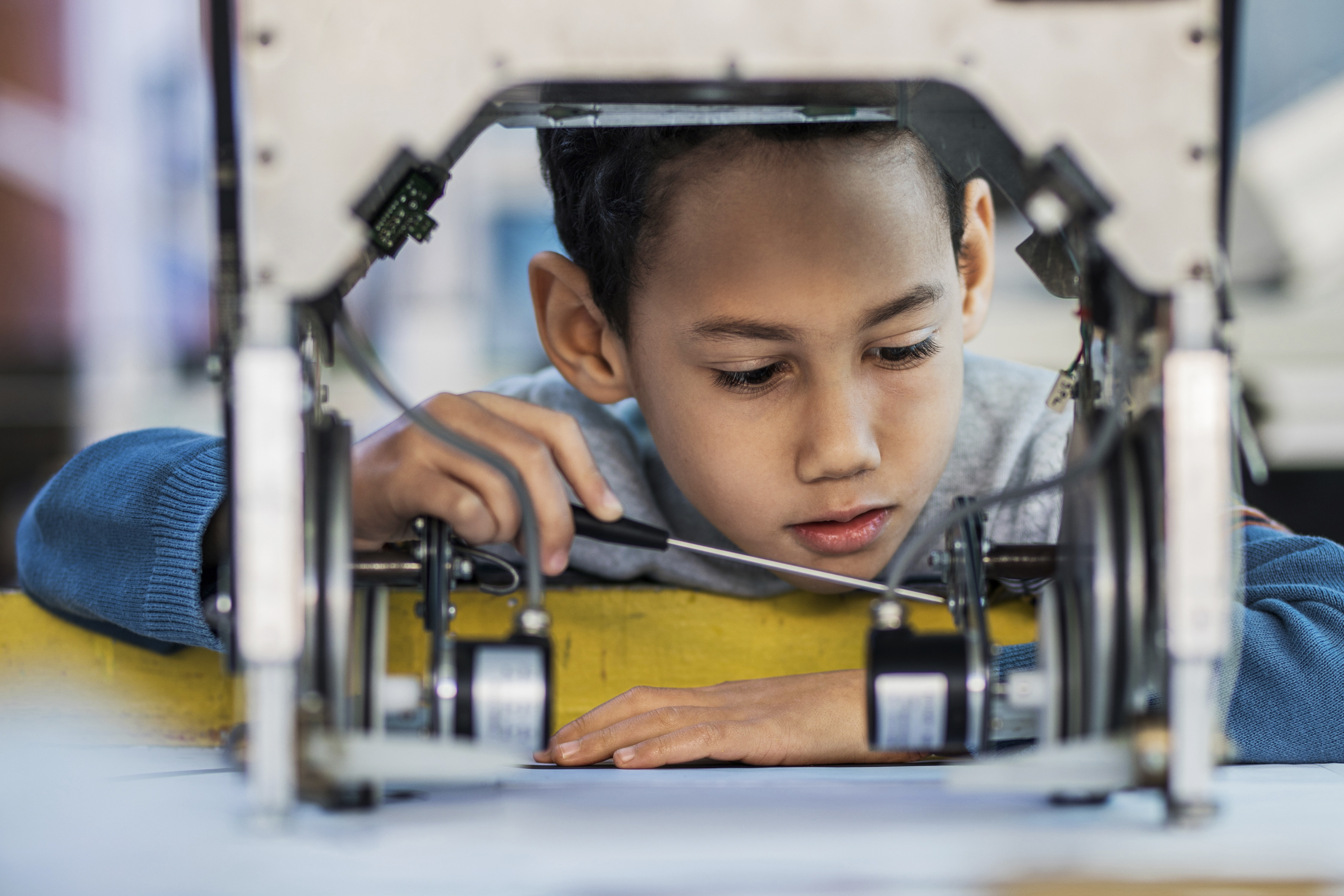
HANDS ON! School makerspaces encourage kids to build, create, and innovate.
SKYNESHER/GETTY IMAGES
Last year, Izzy Goldstein, 12, learned in science class that we can reduce air pollution by using natural energy sources, such as wind and solar power, instead of gasoline. This made her wonder what she and her schoolmates could do to help the environment. “I thought, ‘Maybe if my school got a bike rack, more kids would bike to school instead of relying on cars,’” Izzy told TIME for Kids. Rather than ask their school to buy a rack, Izzy and her friends decided to make it themselves.
They came up with a design. They calculated how much wood they might need. They measured how long the boards should be. They used power tools to cut them and secure them together. And they did all this in their school’s makerspace.
What is a Makerspace?
Makerspaces are work spaces where kids can learn to create objects using technology, engineering, art, and design. These spaces often feature a mix of high-tech machines, such as 3D printers and robotic kits, and simple materials like clay and cardboard.
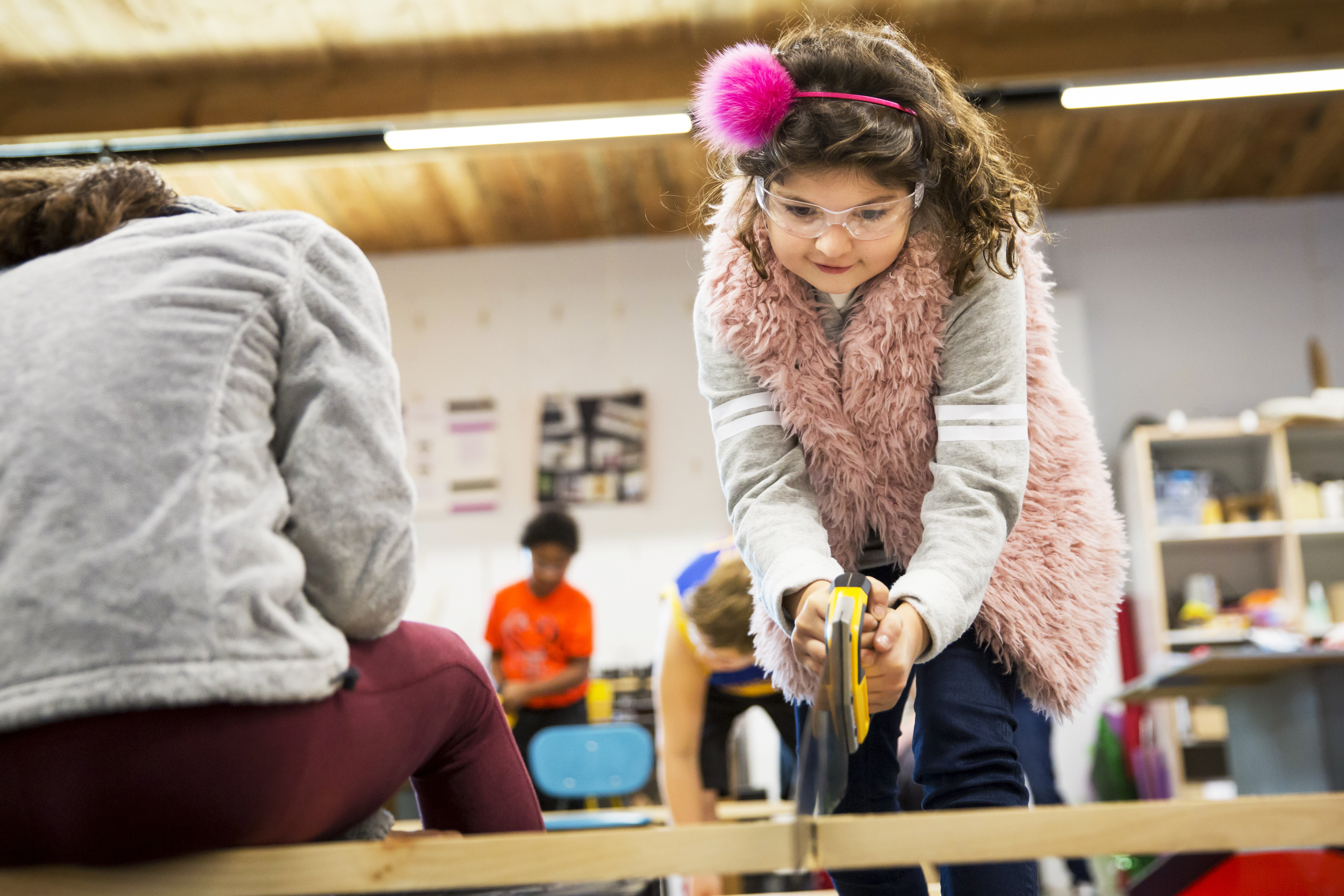
GOGGLES ON! A student at the Harley School saws wood for a table that kids will use outdoors.
ART ROTHFUSS
Izzy goes to the Harley School, in Rochester, New York. It is one of a growing number of schools across the United States with makerspaces. Makerspaces are largely inspired by Maker Faires, which are events that give people a chance to share their creative projects. Each year, about 250,000 people attend the Maker Faires in San Mateo, California, and Queens, New York. Maker Faires have also spread to countries around the world, including Egypt, France, and Thailand.
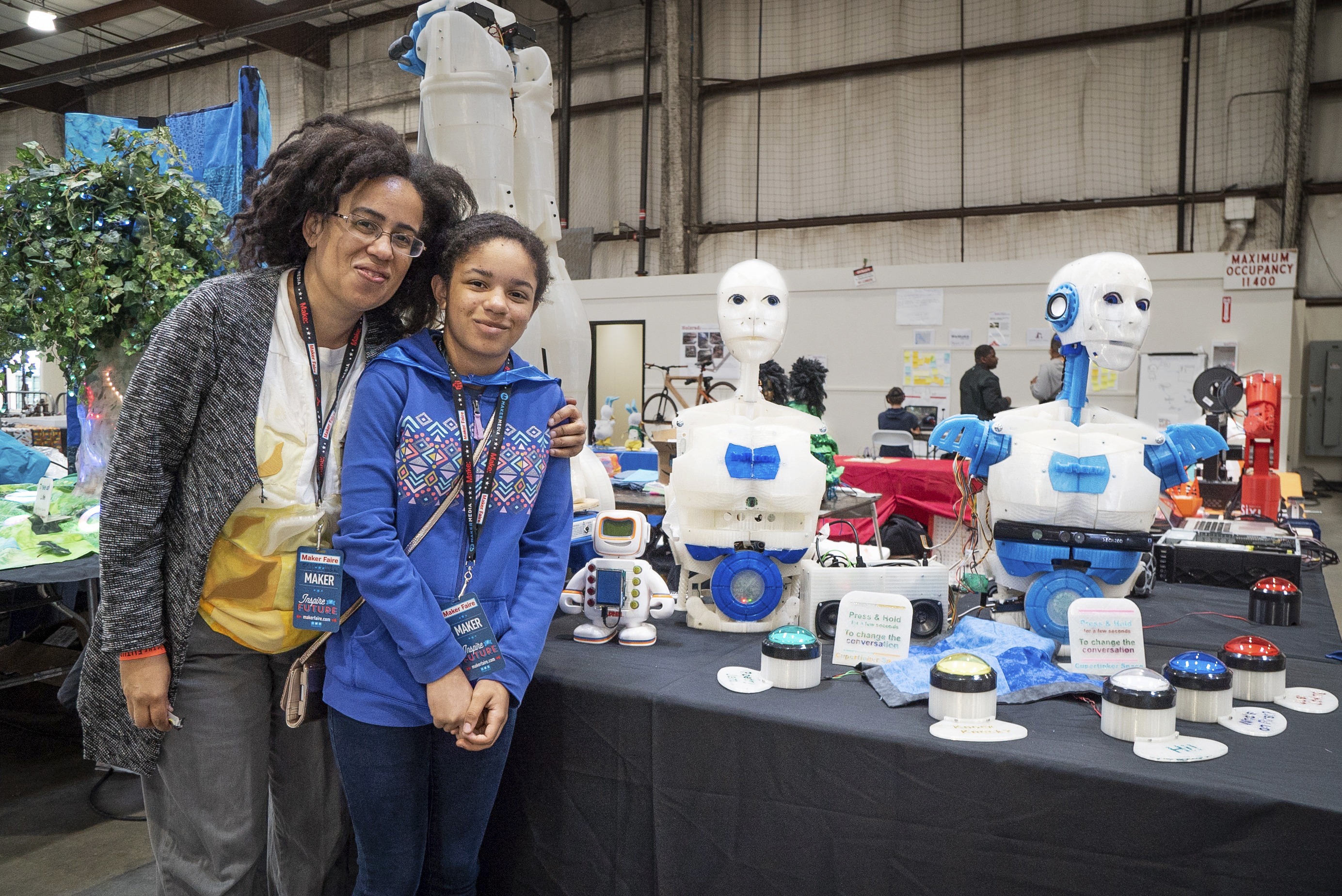
MAKER DUO Lurene Davis, 14, and her mother show their 3D-printed robots at the 2018 Maker Faire in San Mateo, California.
JUN SHENA
Why are schools introducing makerspaces to the curriculum? “It’s hands-on, experiential learning,” Dale Dougherty told TFK. He founded Maker Faire in 2006. “Makerspaces give kids a way to have ideas and build something from those ideas.”
Problem-Solving Play
Kima Enerson is a makerspace teacher at the Harley School. But she says kids can become extraordinary makers in an ordinary classroom, too. In Harley’s Lower School (pre-kindergarten to grade 4),students learn about the basics of computer software. By third grade, they study coding and how electricity works. In sixth grade, they learn to safely use tools such as drills and saws. When students get to high school, Enerson shows them how to apply their skills to solve global problems. “I bring them through the process of designing something to better the world,” she says.
Sometimes, though, students at Harley focus on finding fun solutions to common tasks, such as flipping pancakes. The school’s 12th graders did this with the help of Lego Mindstorms. These construction kits contain Lego building blocks and other materials that kids can use to create robots. The robots can be programmed to follow commands.
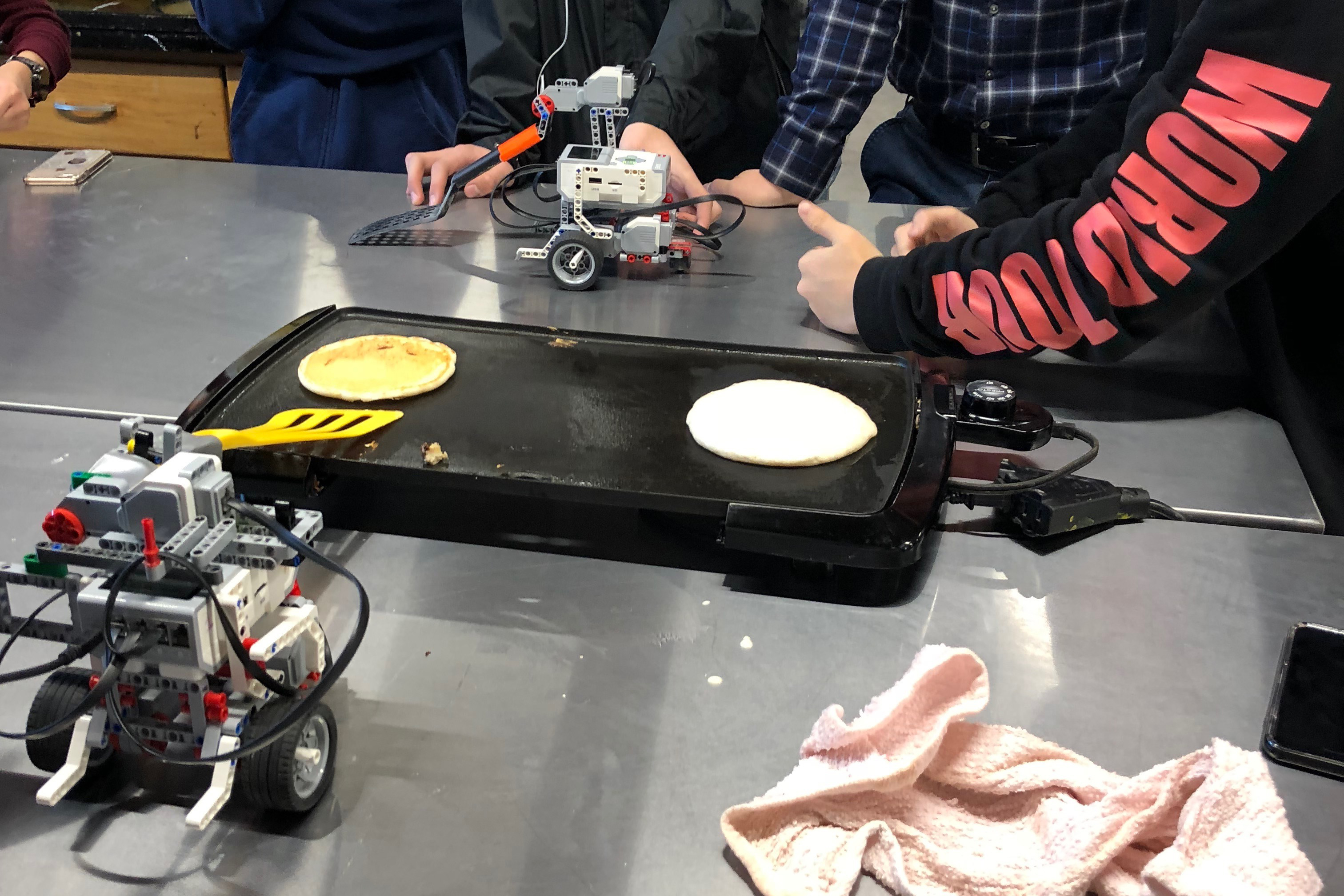
FLIP OUT A robot made with Lego Mindstorms flips pancakes in a Harley School classroom.
KIMA ENERSON
If making a pancake-flipping robot sounds like playing, that’s because it is. “Innovation comes from play,” Dougherty says. “Making is something you do because it’s enjoyable.” Cameron Anderson, an eighth grader at Harley, agrees. When asked what he likes most about his school’s makerspace, he was quick to answer. “It’s fun!” he said.
Clean Solution
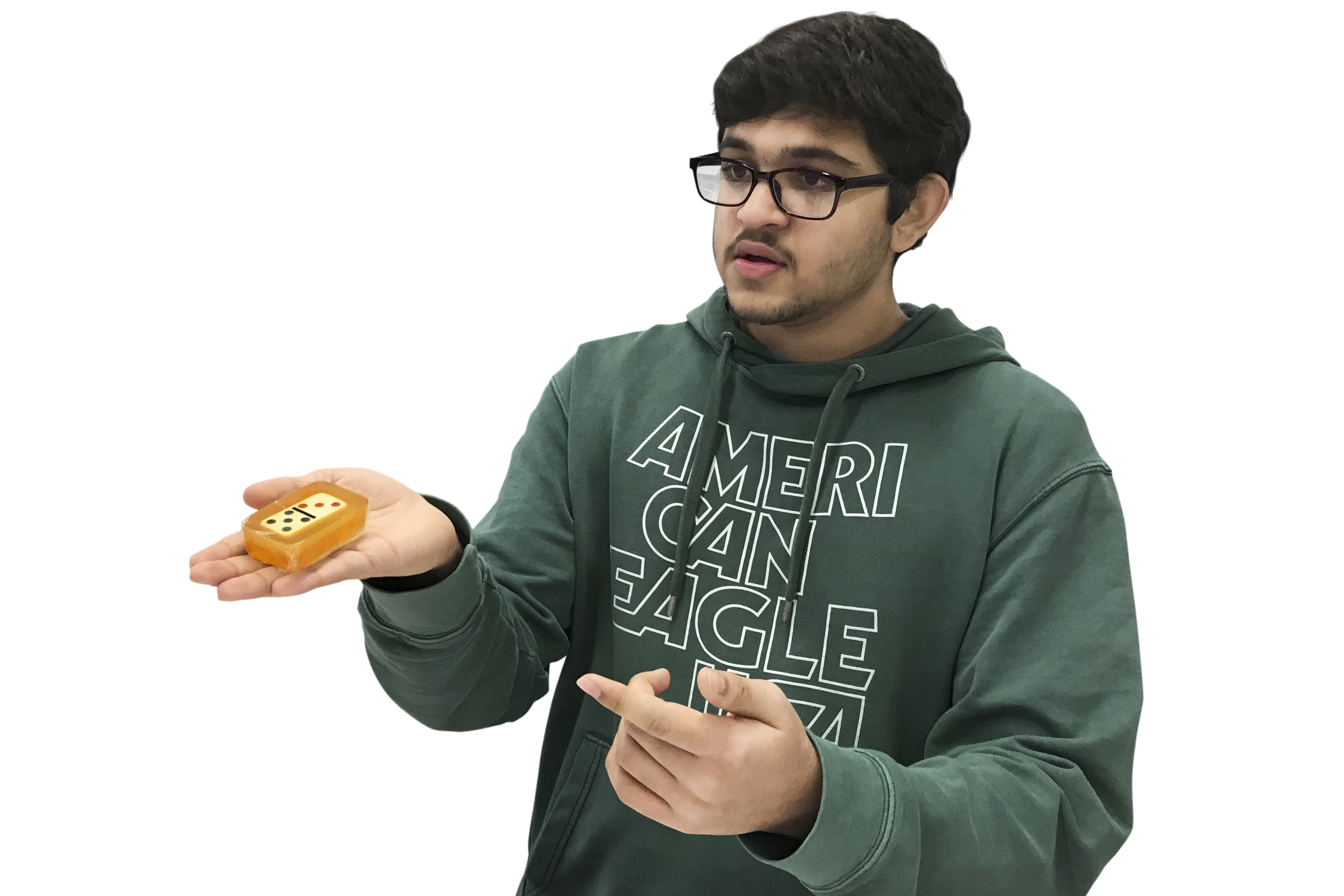
SURESH ANNAPPINDI
Many people toss out soap when a bar gets small. Yashas Anapindi, 15, from Garnet Valley, Pennsylvania, is trying to change that. He wants to maximize soap use to minimize waste. So he created EcoSoap. It’s a bar of soap with a reusable item, such as a domino, in the center. This encourages people to use every last bit of soap to get to the item inside. Yashas presented EcoSoap at the 2018 Maker Faire in New York. “To be a maker, all you need is an imagination,” he told TFK.
Assessment: Click here for a printable quiz.

HANDS ON! School makerspaces encourage kids to build, create, and innovate.
SKYNESHER/GETTY IMAGES
Last year, Izzy Goldstein, 12, learned in science class that we can reduce air pollution by using natural energy sources, such as wind and solar power, instead of gasoline. This made her wonder what she and her schoolmates could do to help the environment. “I thought, ‘Maybe if my school got a bike rack, more kids would bike to school instead of relying on cars,’” Izzy told TIME for Kids. Rather than ask their school to buy a rack, Izzy and her friends decided to make it themselves.
They came up with a design. They calculated how much wood they might need. They measured how long the boards should be. They used power tools to cut them and secure them together. And they did all this in their school’s makerspace.
What is a Makerspace?
Makerspaces are work spaces where kids can learn to create objects using technology, engineering, art, and design. These spaces often feature a mix of high-tech machines, such as 3D printers and robotic kits, and simple materials like clay and cardboard.

GOGGLES ON! A student at the Harley School saws wood for a table that kids will use outdoors.
ART ROTHFUSS
Izzy goes to the Harley School, in Rochester, New York. It is one of a growing number of schools across the United States with makerspaces. Makerspaces are largely inspired by Maker Faires, which are events that give people a chance to share their creative projects. Each year, about 250,000 people attend the Maker Faires in San Mateo, California, and Queens, New York. Maker Faires have also spread to countries around the world, including Egypt, France, and Thailand.

MAKER DUO Lurene Davis, 14, and her mother show their 3D-printed robots at the 2018 Maker Faire in San Mateo, California.
JUN SHENA
Why are schools introducing makerspaces to the curriculum? “It’s hands-on, experiential learning,” Dale Dougherty told TFK. He founded Maker Faire in 2006. “Makerspaces give kids a way to have ideas and build something from those ideas.”
Problem-Solving Play
Kima Enerson is a makerspace teacher at the Harley School. But she says kids can become extraordinary makers in an ordinary classroom, too. In Harley’s Lower School (pre-kindergarten to grade 4),students learn about the basics of computer software. By third grade, they study coding and how electricity works. In sixth grade, they learn to safely use tools such as drills and saws. When students get to high school, Enerson shows them how to apply their skills to solve global problems. “I bring them through the process of designing something to better the world,” she says.
Sometimes, though, students at Harley focus on finding fun solutions to common tasks, such as flipping pancakes. The school’s 12th graders did this with the help of Lego Mindstorms. These construction kits contain Lego building blocks and other materials that kids can use to create robots. The robots can be programmed to follow commands.

FLIP OUT A robot made with Lego Mindstorms flips pancakes in a Harley School classroom.
KIMA ENERSON
If making a pancake-flipping robot sounds like playing, that’s because it is. “Innovation comes from play,” Dougherty says. “Making is something you do because it’s enjoyable.” Cameron Anderson, an eighth grader at Harley, agrees. When asked what he likes most about his school’s makerspace, he was quick to answer. “It’s fun!” he said.
Clean Solution

SURESH ANNAPPINDI
Many people toss out soap when a bar gets small. Yashas Anapindi, 15, from Garnet Valley, Pennsylvania, is trying to change that. He wants to maximize soap use to minimize waste. So he created EcoSoap. It’s a bar of soap with a reusable item, such as a domino, in the center. This encourages people to use every last bit of soap to get to the item inside. Yashas presented EcoSoap at the 2018 Maker Faire in New York. “To be a maker, all you need is an imagination,” he told TFK.
Assessment: Click here for a printable quiz.
Curious Minds
by TFK Kid Reporter Will Holland
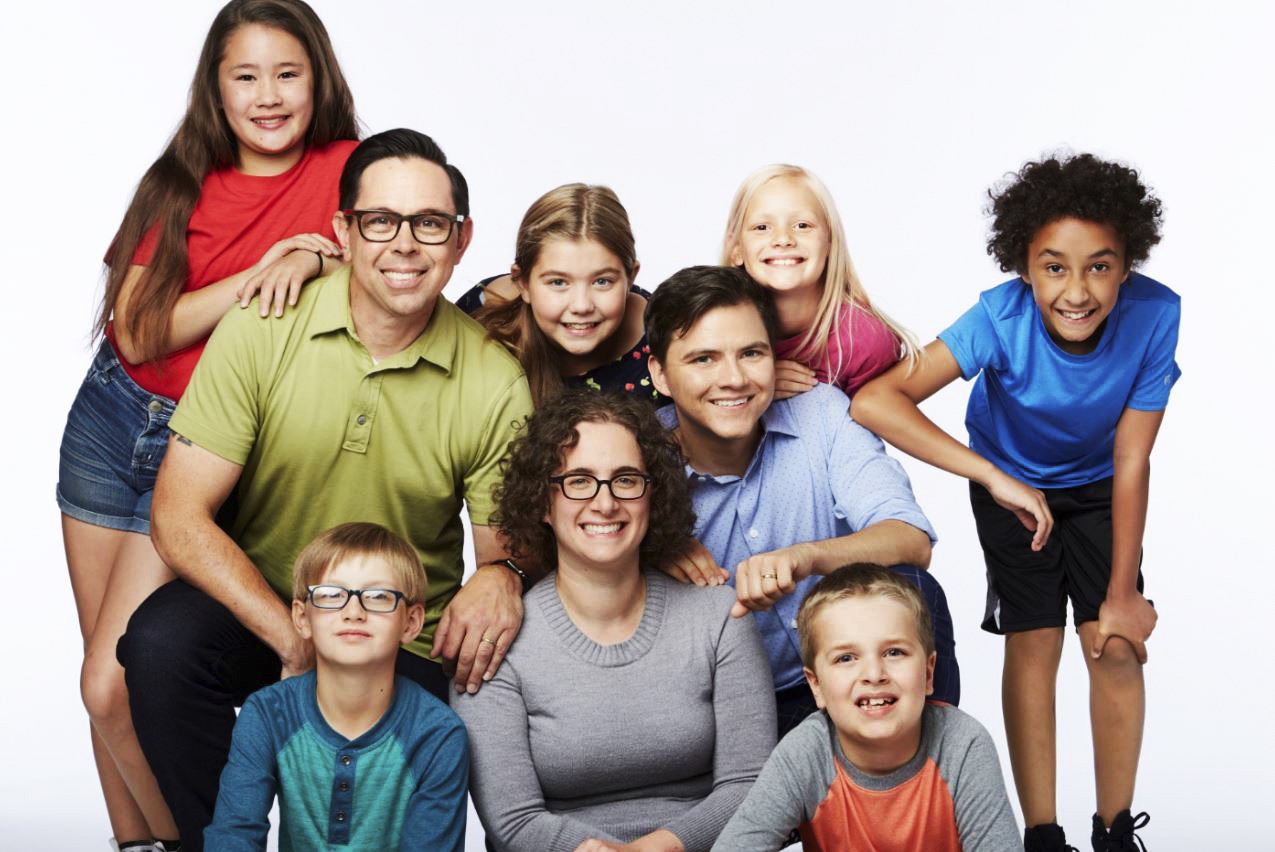
Do you ever wonder what your dog is thinking? Or what makes paint stick? Get answers to these questions and many more with the podcast Brains On!
Each episode of Brains On! begins with a question submitted by a kid. Host MOLLY BLOOM (pictured, center) then takes listeners on an adventure through the worlds of science and history in search of the answer. She’s joined by curious kids who serve as her cohosts.
“We wanted to make something for kids because we know that they are really smart and interested in the world,” Bloom told TFK Kid Reporter Will Holland.
SANDEN TOTTEN (pictured, in light-blue shirt) is a writer for Brains On!He hopes the show inspires kids to ask questions. “Any question you have is worth looking into,” he says.

Do you ever wonder what your dog is thinking? Or what makes paint stick? Get answers to these questions and many more with the podcast Brains On!
Each episode of Brains On! begins with a question submitted by a kid. Host MOLLY BLOOM (pictured, center) then takes listeners on an adventure through the worlds of science and history in search of the answer. She’s joined by curious kids who serve as her cohosts.
“We wanted to make something for kids because we know that they are really smart and interested in the world,” Bloom told TFK Kid Reporter Will Holland.
SANDEN TOTTEN (pictured, in light-blue shirt) is a writer for Brains On!He hopes the show inspires kids to ask questions. “Any question you have is worth looking into,” he says.
Sunday, February 24, 2019
Measles Alert
by Brian S. McGrath

DOCTOR’S ORDERS The vaccine known as MMR can give lifelong protection against measles.
GETTY IMAGES
People in Washington and Oregon are rushing to get a vaccine that can protect them from the measles virus. About 4,500 people in Clark County, Washington, were vaccinated between January 13 and February 2.
Why the concern? Washington and Oregon have seen a measles outbreak. More than 50 people were infected, most of them children.
Measles is a virus that lives in the nose and throat. Illness starts with cold-like symptoms, followed by a rash. The virus can spread to others through coughing and sneezing. This makes it highly contagious. If one person has measles, 90% of the people close by will become infected if they have not been immunized.
Outbreaks typically occur where groups of people are not vaccinated. In Clark County, only 78% of kids had received the measles vaccine. Health authorities say a community must have an immunization rate of 95% to be safe against the virus.
In 17 states, the law lets parents choose not to have a child vaccinated for an unspecified personal reason. Washington lawmakers are reviewing their state’s law.
“There’s no reason we should be having this outbreak,” says Alan Melnick. He is director of public health for Clark County. “We have vaccines that are very cheap, very effective, and very, very safe.”

DOCTOR’S ORDERS The vaccine known as MMR can give lifelong protection against measles.
GETTY IMAGES
People in Washington and Oregon are rushing to get a vaccine that can protect them from the measles virus. About 4,500 people in Clark County, Washington, were vaccinated between January 13 and February 2.
Why the concern? Washington and Oregon have seen a measles outbreak. More than 50 people were infected, most of them children.
Measles is a virus that lives in the nose and throat. Illness starts with cold-like symptoms, followed by a rash. The virus can spread to others through coughing and sneezing. This makes it highly contagious. If one person has measles, 90% of the people close by will become infected if they have not been immunized.
Outbreaks typically occur where groups of people are not vaccinated. In Clark County, only 78% of kids had received the measles vaccine. Health authorities say a community must have an immunization rate of 95% to be safe against the virus.
In 17 states, the law lets parents choose not to have a child vaccinated for an unspecified personal reason. Washington lawmakers are reviewing their state’s law.
“There’s no reason we should be having this outbreak,” says Alan Melnick. He is director of public health for Clark County. “We have vaccines that are very cheap, very effective, and very, very safe.”
Saturday, February 23, 2019
Scout Me In!
by Rebecca Katzman
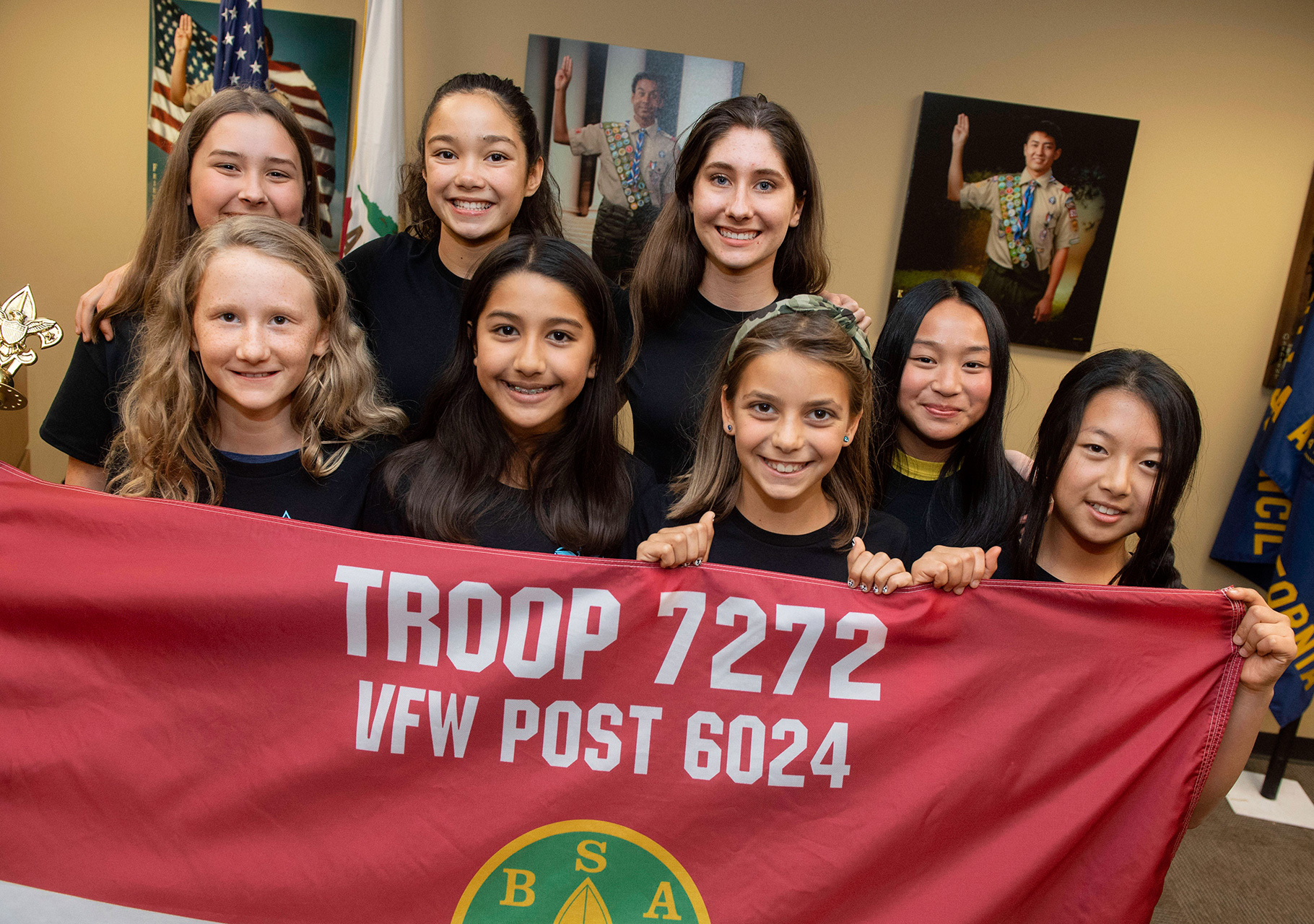
NEXT GENERATION LEADERS In Costa Mesa, California, eight girls from a new Scouts BSA troop pose for a photo.
KEVIN SULLIVAN—MEDIANEWS GROUP/ORANGE COUNTY REGISTER/GETTY IMAGES
The Boy Scouts have been teaching leadership skills to kids for more than a hundred years. Now, the Boy Scouts are opening up to girls. On February 1, the first group of girls, ages 11 to 17, joined a new program called Scouts BSA. A girl will now be able to work toward becoming an Eagle Scout. That’s the highest rank in the program.
“I could not be more excited for what this means for the next generation of leaders,” chief scout executive Michael Surbaugh said in a statement.
Cub Scouts, the group’s program for younger kids, has been welcoming girls since last year. So far, more than 77,000 girls have joined.
Alex Sobtzak has kids who are scouts. “I am so excited that my daughters will have the same opportunities as my sons,” he says.
Friday, February 22, 2019
National FFA Week By Carson Cinniger
As you may know it this week is National FFA Week. Mrs.Nuhfer is the FFA teacher here in Willard City Schools. When asked, “Why do you celebrate FFA?” She quickly responded, “I like to teach about Vo Ag to inspire people to join FFA when they are in high school.” “Why do you think others should celebrate Vo Ag?” She said, “It gives an opportunity for people to join FFA,” As I looked up I saw a determined face and you could tell she wanted more people to try FFA. But how did she get into this line of work? She said that when she was in a student she was in 4H and once she got into high school she knew what she wanted to do, but not only join FFA she wanted to teach about it, so that's what she did. I knew I had been in her hair for a little too long so I asked one more question, What is your favorite thing about FFA?” She Proudly said, “ It gives people skill for work when they get out of school and If they have a job at a farm they know what to do.” Not only is Mrs. Nuhfer a great teacher, but she is also a really good role model for students.
On Point
by Shay Maunz

MAKEUP TRICK Here, Jenelle Henry wears shoes she colored to match her skin.
RACHEL NEVILLE
Jenelle Henry started ballet classes when she was 3. When she was around 10, her teachers said she could begin to train en pointe. This meant she would learn to dance on the tips of her toes.
Jenelle bought a special pair of shoes called point shoes, which are reinforced with glue and paper to protect a dancer’s foot. But there was a problem: The shoes were only available in the traditional color, which is often called ballet pink. It’s a shade of pale pink that resembles a dancer’s skin—if that dancer is white. But Jenelle is African American. She’s a student at Dance Theatre of Harlem (DTH), a ballet school and dance company in New York City for dancers of color. Traditional ballet shoes don’t match the skin tone of most DTH dancers. The school asks that dancers color their point shoes to match their skin.
To match her first pair of point shoes to her skin tone, Jenelle used spray paint. It left them looking blotchy. Older dancers at DTH taught her their favorite method: makeup applied with a sponge. The technique is costly and time-consuming, but it does the job. “I’ve used that strategy since I was 11,” Jenelle, now 14, told TIME for Kids. “Later, I started passing it down to younger kids.” The makeup trick is common among dancers of color. That’s because most point shoes are not available in brown or tan. But that’s changing.
New Shoes
Freed of London is one of the world’s largest suppliers of point shoes. In late 2018, the company introduced shoes in two new colors: ballet brown and ballet bronze. The colors are the result of a partnership between Freed and Ballet Black, a British ballet company. Cassa Pancho is Ballet Black’s founder. The shoes, she says, are “another step forward for culturally diverse dancers across the globe.”
In recent years, ballet schools and dance companies have worked to encourage diversity. In 2015, Misty Copeland became the first African-American woman promoted to principal dancer at New York City’s prestigious American Ballet Theater. She is a role model for young dancers around the world, including Jenelle.
Jenelle says ready-made brown ballet shoes could help young dancers of color feel more at home in the ballet world. “It’s very exciting to see this break from generic pink everything,” she says. “I think it will motivate more young kids to join the ballet world.”

MAKEUP TRICK Here, Jenelle Henry wears shoes she colored to match her skin.
RACHEL NEVILLE
Jenelle Henry started ballet classes when she was 3. When she was around 10, her teachers said she could begin to train en pointe. This meant she would learn to dance on the tips of her toes.
Jenelle bought a special pair of shoes called point shoes, which are reinforced with glue and paper to protect a dancer’s foot. But there was a problem: The shoes were only available in the traditional color, which is often called ballet pink. It’s a shade of pale pink that resembles a dancer’s skin—if that dancer is white. But Jenelle is African American. She’s a student at Dance Theatre of Harlem (DTH), a ballet school and dance company in New York City for dancers of color. Traditional ballet shoes don’t match the skin tone of most DTH dancers. The school asks that dancers color their point shoes to match their skin.
To match her first pair of point shoes to her skin tone, Jenelle used spray paint. It left them looking blotchy. Older dancers at DTH taught her their favorite method: makeup applied with a sponge. The technique is costly and time-consuming, but it does the job. “I’ve used that strategy since I was 11,” Jenelle, now 14, told TIME for Kids. “Later, I started passing it down to younger kids.” The makeup trick is common among dancers of color. That’s because most point shoes are not available in brown or tan. But that’s changing.
New Shoes
Freed of London is one of the world’s largest suppliers of point shoes. In late 2018, the company introduced shoes in two new colors: ballet brown and ballet bronze. The colors are the result of a partnership between Freed and Ballet Black, a British ballet company. Cassa Pancho is Ballet Black’s founder. The shoes, she says, are “another step forward for culturally diverse dancers across the globe.”
In recent years, ballet schools and dance companies have worked to encourage diversity. In 2015, Misty Copeland became the first African-American woman promoted to principal dancer at New York City’s prestigious American Ballet Theater. She is a role model for young dancers around the world, including Jenelle.
Jenelle says ready-made brown ballet shoes could help young dancers of color feel more at home in the ballet world. “It’s very exciting to see this break from generic pink everything,” she says. “I think it will motivate more young kids to join the ballet world.”
Thursday, February 21, 2019
8 Questions for Evan Barnard
by Kio Herrera
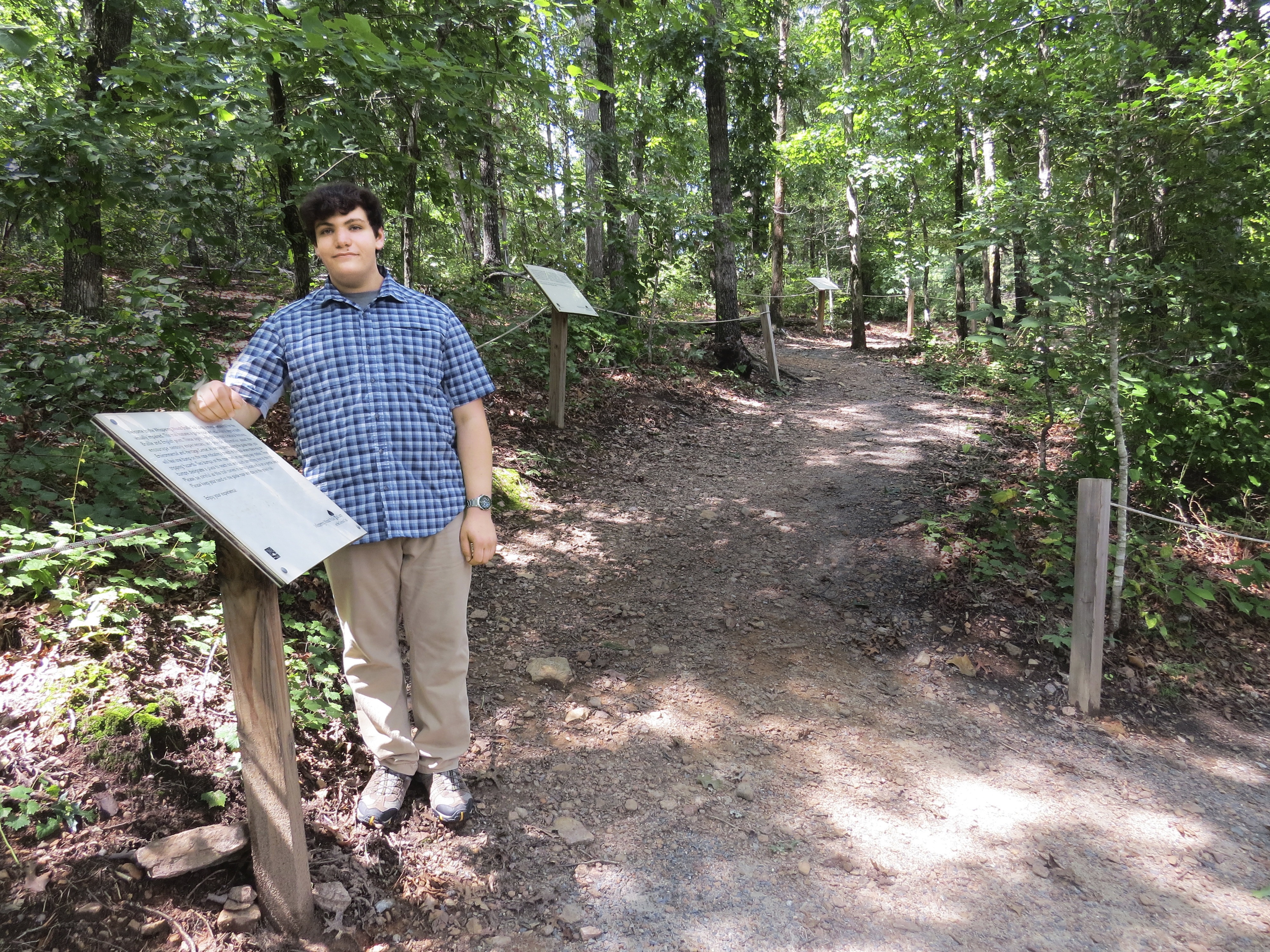
TRAILBLAZER Evan Barnard created Whispering Woods, a nature trail for the blind.
COURTESY EVAN BARNARD
When he was a kid, Evan Barnard, now 19, learned that someone had damaged a Braille nature trail. People who are blind or have low vision use these trails to explore nature. Barnard helped fix the trail. Then he set out to create a new one. He spoke about his efforts with TFK’s Kio Herrera.
1. What exactly is a Braille nature trail?
A Braille nature trail is a footpath that uses elements like guide ropes and Braille signs to help the visually impaired enjoy nature unassisted. There are spots along the trail where visitors can touch scratchy tree bark, listen to birds, or smell flowers.
2. You designed and built Whispering Woods, a trail in Buford, Georgia. Tell us about it.
It took about two years to complete the trail. I chose the name Whispering Woods because of the sound the wind makes when it goes through the oak leaves. The most important part was having members of the blind community test it. I wanted to include the people that would benefit from it the most.
3. How have visitors reacted to Whispering Woods?
Being outdoors can be unfamiliar for many of them. I remember a student on one of my guided nature walks who was very nervous to be in an open area. But once the walk was over, he immediately wanted to do it again. It’s a transformative experience for many of our visitors.
4. Why do you think it is important for visually impaired people to experience nature?
Experiencing nature is important for everyone, regardless of physical capability. But visually impaired people have limited access to nature. A Braille nature trail allows them to be outdoors and independent.
5. What is the biggest challenge in making nature accessible to everyone?
Braille trails, sensory gardens, and other outdoor opportunities exist all over the world. The problem is, most people are not aware of them. I created an online directory to help solve this problem. There, people can find accessible trails close to where they live.
6. What’s the biggest lesson you have learned from the visually impaired community?
I’ve worked with members of this community for the past nine years, and I consider many of them my friends. They’ve taught me so much about overcoming obstacles and appreciating the world around us.
7. You were a youth delegate for the United Nations because of your work. What was that like?
It was very powerful because I got to meet hundreds of like-minded people. Together, we looked at solutions to issues affecting communities around the world. I would definitely recommend finding people from all types of communities to share your ideas with.
8. Do you have any advice for kids who want to make their community more accessible to others?
You don’t have to start your own organization to make an impact on people’s lives. Get to know the people in your neighborhood, figure out what they need, and let them be a part of your project.

TRAILBLAZER Evan Barnard created Whispering Woods, a nature trail for the blind.
COURTESY EVAN BARNARD
When he was a kid, Evan Barnard, now 19, learned that someone had damaged a Braille nature trail. People who are blind or have low vision use these trails to explore nature. Barnard helped fix the trail. Then he set out to create a new one. He spoke about his efforts with TFK’s Kio Herrera.
1. What exactly is a Braille nature trail?
A Braille nature trail is a footpath that uses elements like guide ropes and Braille signs to help the visually impaired enjoy nature unassisted. There are spots along the trail where visitors can touch scratchy tree bark, listen to birds, or smell flowers.
2. You designed and built Whispering Woods, a trail in Buford, Georgia. Tell us about it.
It took about two years to complete the trail. I chose the name Whispering Woods because of the sound the wind makes when it goes through the oak leaves. The most important part was having members of the blind community test it. I wanted to include the people that would benefit from it the most.
3. How have visitors reacted to Whispering Woods?
Being outdoors can be unfamiliar for many of them. I remember a student on one of my guided nature walks who was very nervous to be in an open area. But once the walk was over, he immediately wanted to do it again. It’s a transformative experience for many of our visitors.
4. Why do you think it is important for visually impaired people to experience nature?
Experiencing nature is important for everyone, regardless of physical capability. But visually impaired people have limited access to nature. A Braille nature trail allows them to be outdoors and independent.
5. What is the biggest challenge in making nature accessible to everyone?
Braille trails, sensory gardens, and other outdoor opportunities exist all over the world. The problem is, most people are not aware of them. I created an online directory to help solve this problem. There, people can find accessible trails close to where they live.
6. What’s the biggest lesson you have learned from the visually impaired community?
I’ve worked with members of this community for the past nine years, and I consider many of them my friends. They’ve taught me so much about overcoming obstacles and appreciating the world around us.
7. You were a youth delegate for the United Nations because of your work. What was that like?
It was very powerful because I got to meet hundreds of like-minded people. Together, we looked at solutions to issues affecting communities around the world. I would definitely recommend finding people from all types of communities to share your ideas with.
8. Do you have any advice for kids who want to make their community more accessible to others?
You don’t have to start your own organization to make an impact on people’s lives. Get to know the people in your neighborhood, figure out what they need, and let them be a part of your project.
Wednesday, February 20, 2019
Dragon and Rider
by Belle Irby

DREAMWORKS ANIMATION
How to Train Your Dragon: The Hidden World is the third and final film in the beloved How to Train Your Dragon trilogy. The new movie, which lands in theaters February 22, begins on Berk, a magical island where dragons and Vikings live in harmony. Berk is ruled by a Viking named Hiccup. Hiccup’s best friend, a dragon named Toothless, is always by his side.
But Hiccup and Toothless encounter danger on their peaceful island. They must journey to a land they once thought existed only in legend. As they fight to defend their home, the two learn lessons about bravery and accepting change.
Actor JAY BARUCHEL is the voice of Hiccup. He told TFK Kid Reporter Belle Irby that when he was young, he had to learn to be brave, just like Hiccup. What did he need bravery for? “Roller coasters and speaking in front of others,” he says. “Those took courage.”

DREAMWORKS ANIMATION
How to Train Your Dragon: The Hidden World is the third and final film in the beloved How to Train Your Dragon trilogy. The new movie, which lands in theaters February 22, begins on Berk, a magical island where dragons and Vikings live in harmony. Berk is ruled by a Viking named Hiccup. Hiccup’s best friend, a dragon named Toothless, is always by his side.
But Hiccup and Toothless encounter danger on their peaceful island. They must journey to a land they once thought existed only in legend. As they fight to defend their home, the two learn lessons about bravery and accepting change.
Actor JAY BARUCHEL is the voice of Hiccup. He told TFK Kid Reporter Belle Irby that when he was young, he had to learn to be brave, just like Hiccup. What did he need bravery for? “Roller coasters and speaking in front of others,” he says. “Those took courage.”
Tuesday, February 19, 2019
Nick Bauer to Represent Willard at State Swim Meet
Tomorrow we will be marching Nick Bauer through the entire school to send him off to the State swim meet. This will take place at 2 pm. Let's cheer Nick on as he and the band march through the halls!
Honor Run
Hello runners and walkers!
Our 2nd annual 5K Honor run/walk is just around the corner!
We are striving to make this year's event bigger and better than last year!
Please sign up by THIS FRIDAY so that we can make sure you are guaranteed a t-shirt, medal and additional items for this event.
As a staff member with school insurance, your registration of $25 is generously covered by your Willard Wellness Warriors.
All proceeds go towards out Veterans Programs and future seats on Honor Flight for veterans.
Just click on this link to register: tinyurl.com/honorrun19
Please feel free to contact anyone you know that might be interested in joining the fun. We are trying to get as many people as we can involved in our race!
PLEASE DON'T FORGET TO REGISTER BY FRIDAY, FEBRUARY 22ND!
Getting Even
by Rebecca Katzman
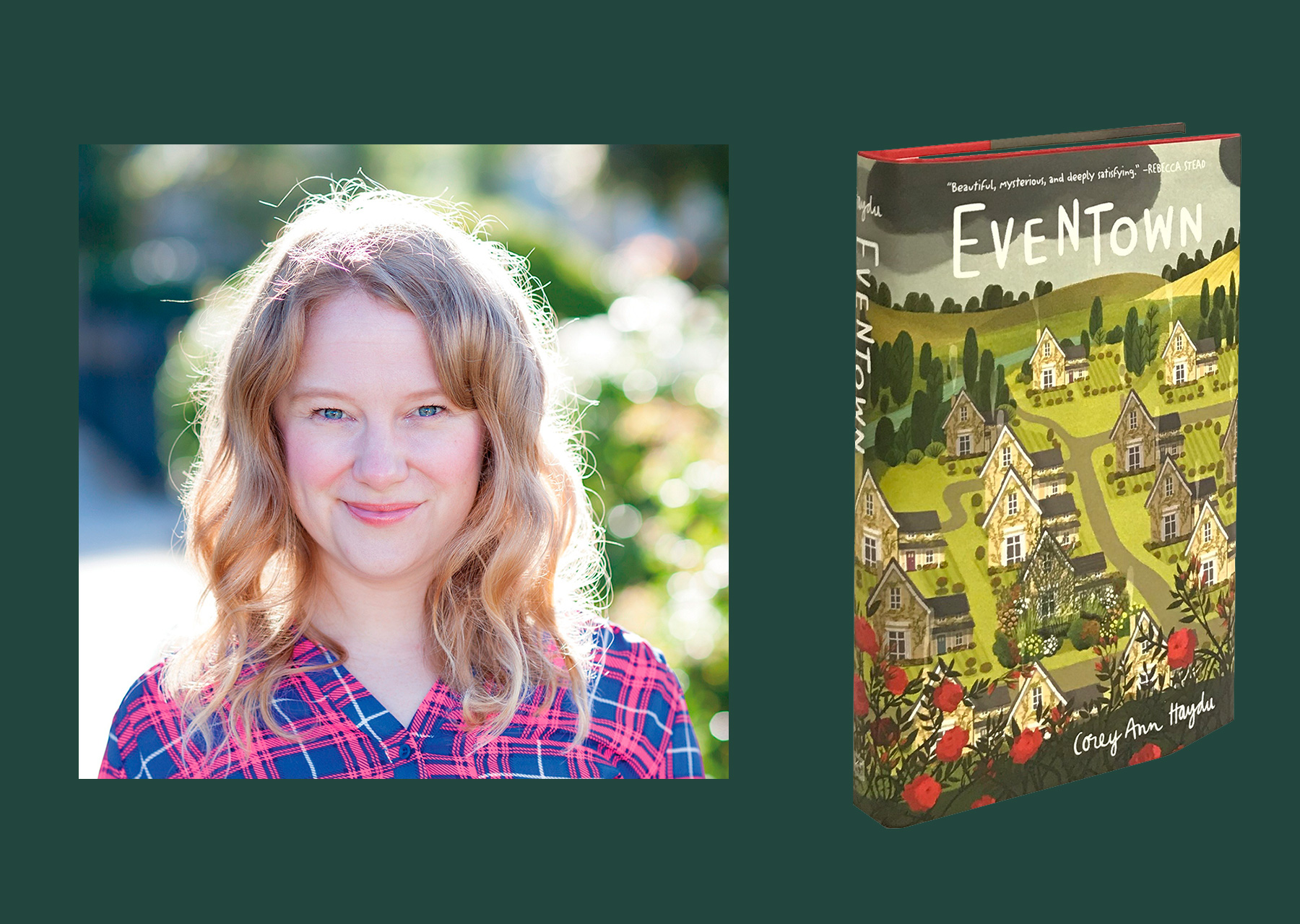
FROM LEFT: JESSIE WEINBERG; STEPHEN BLUE FOR TIME FOR KIDS
At first, Eventown seems ideal. It’s a town filled with perfectly ripe blueberries, fast-growing rosebushes, and the world’s tastiest ice cream. It’s just the right place for Elodee and her family to move to when they’re looking for a fresh start. But before long, Elodee realizes something is wrong. All the houses in Eventown look the same, and the books in the library are blank. Plus, that tasty ice cream only comes in three flavors. Strangest of all, no one questions any of this—no one but Elodee.
Author COREY ANN HAYDU (pictured) doesn’t shy away from tough topics in her books. Eventown is no exception. Haydu told TFK that the book is about the power of being vulnerable. “Being vulnerable is the bravest thing you can do,” she says. “Bravery comes from really showing yourself and opening up to others."

FROM LEFT: JESSIE WEINBERG; STEPHEN BLUE FOR TIME FOR KIDS
At first, Eventown seems ideal. It’s a town filled with perfectly ripe blueberries, fast-growing rosebushes, and the world’s tastiest ice cream. It’s just the right place for Elodee and her family to move to when they’re looking for a fresh start. But before long, Elodee realizes something is wrong. All the houses in Eventown look the same, and the books in the library are blank. Plus, that tasty ice cream only comes in three flavors. Strangest of all, no one questions any of this—no one but Elodee.
Author COREY ANN HAYDU (pictured) doesn’t shy away from tough topics in her books. Eventown is no exception. Haydu told TFK that the book is about the power of being vulnerable. “Being vulnerable is the bravest thing you can do,” she says. “Bravery comes from really showing yourself and opening up to others."
Friday, February 15, 2019
FFA Week Dress Down Days - All Next Week!
FFA WEEK
_________________________________
Tuesday: Red, white, black, green, yellow
Wednesday: Sweatpants
($1 donation to children’s hospital)
Thursday: Dress like a farmer
Friday: FFA blue & gold
Middle School Students To Participate in Solo and Ensemble Contest by Jessica Lopez-Mazariegos
Students involved in the Middle School musical arts are extremely excited to announce that our Solo and Ensemble is finally here. Each year kids who are involved in choir, orchestra, and band get to play a piece of music for a few judges to see how well they’re doing. Some kids get to do their own solo if they’re brave enough, and some chose to get into groups or ensembles to play a piece all together. All the musicians who go are being judged and ranked. You can get a ranking score from one to five, five being the lowest score and one being the best score. There are many schools around that are also involved in the competition and the students get to see it as some practice before our big spring concert. This year we are lucky enough to be able to host the event at Willard City School, instead of having to travel a great distance for it. All the kids get a few weeks to practice and prepare their piece, but it is very stressful trying to get everything perfect. Even if we can’t get it to perfection, we all know it doesn’t matter where you rank just as long as you had fun. I cannot wait to see with the middle schoolers will prepare for the Solo and Ensemble this year and see how well they will rank.
Thursday, February 14, 2019
Flashes News Network Team Presenting At #OETC19
On Wednesday, February 13th, the 6th Grade Flashes News Network team presenting at The Ohio Educational Technology Conference in Columbus. Mr. Beddingfield said, "The team did a great job!" The team consisting of Mr. Graybeal, Katelyn Green, Abby Wallace, Morgan Lofland, Luke Smith, Bryson Lykins, Jackson Beamer, Cullen Hill and Mr. Beddingfield.
demonstrated how the Willard Middle School daily announcements are created and presented to the students, staff and parents. Other educators around the state came to hear how they might be able to apply this concept within their own school.
Wednesday, February 13, 2019
Blizzard Bags, Good or Bad? By: Caleb Oulsey and Gavin Huff
Blizzard bags can have many pros and cons depending on what class and what grade you are in. Our first blizzard bag was on January 31st and our second bag was on February 11th. For example, it is better than having extra days but it can be very overwhelming. Another positive side of it is that it takes up less time then a normal school day would. You also have two weeks to complete each blizzard bag. I believe this is very fair for us students. A lot of times, blizzard bags to not cover the material that we’re learning right now in class. One very negative side of blizzard bags is that students may not have access to them the day that they are assigned. In the end, blizzard bags are needed and very important.
Monday, February 11, 2019
Friday, February 8, 2019
Thursday, February 7, 2019
Wednesday, February 6, 2019
Tuesday, February 5, 2019
Monday, February 4, 2019
Friday, February 1, 2019
Subscribe to:
Posts (Atom)









